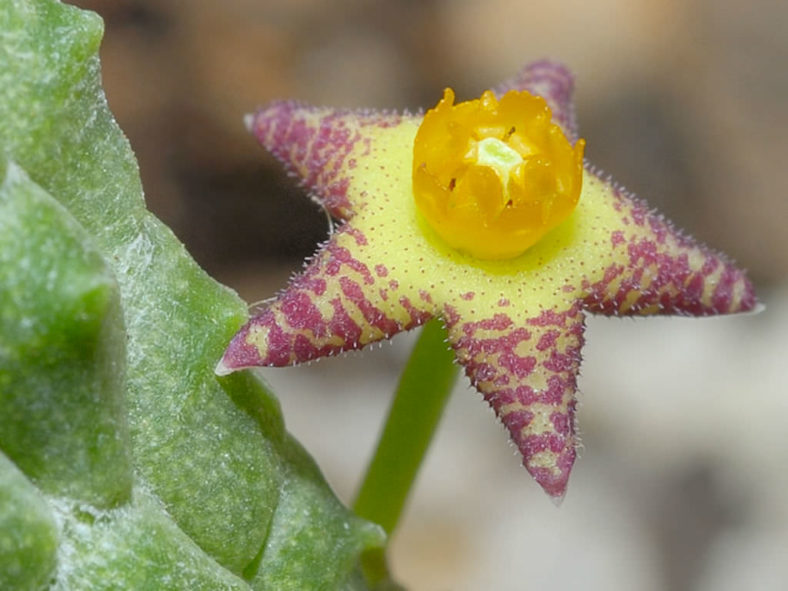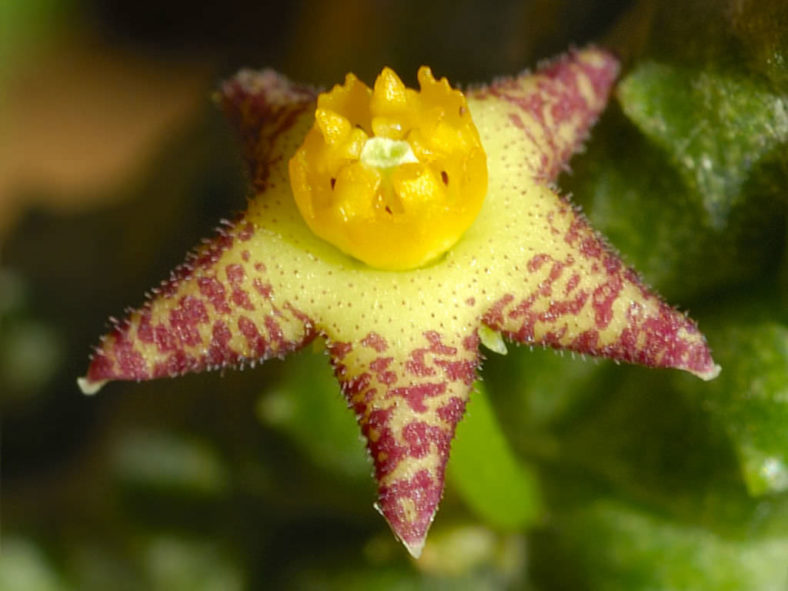Scientific Name
Notechidnopsis tessellata (Pillans) Lavranos & Bleck
Synonym(s)
Caralluma tessellata, Ceropegia tessellata, Echidnopsis framesii, Echidnopsis tessellata
Scientific Classification
Family: Apocynaceae
Subfamily: Asclepiadoideae
Genus: Notechidnopsis
Origin
Notechidnopsis tessellata is native to South Africa. It occurs on shale slopes, creeping among stones and under small bushes on the southern edge of Namaqualand at elevations between 980 and 2,300 feet (300 and 700 m).
Description
Notechidnopsis tessellata is a small, sparingly branched succulent with green to purplish-green stems featuring low tubercles arranged in 6 to 8 rows along the stem. The stems are prostrate to decumbent and can grow up to 6 inches (15 cm) long and 0.6 inches (1.5 cm) thick.
The inflorescences, which have 1 to 5 flowers, appear in the upper half of the stems in the fall. The flowers are star-shaped and can reach a diameter of 0.4 inches (1 cm). Outside, the corolla is smooth and greyish-white, while inside it is rose-purple, speckled with yellow, becoming uniformly pale yellow towards the center, and covered with tiny, sharp-pointed bristles. The corona is bright yellow.

Hardiness
USDA hardiness zone 10a to 11b: from 30 °F (−1.1 °C) to 50 °F (+10 °C).
How to Grow and Care
Stapeliads are relatively easy to grow. However, they should be treated as outdoor plants as they will easily rot indoors and cannot flower without exposure to outdoor temperature fluctuations. They should be grown under cover so that watering can be controlled. They require a reasonable amount of sunlight to promote flowering and maintain a well-shaped plant. Very shady positions will produce very poor flowering.
Stapeliads come from climates where they survive extremely high temperatures in the summer months, so most growth is in spring and autumn, with flowering in autumn when the weather starts to cool down. Water in moderation when needed during the growing season, ensuring the soil is pretty dried out between waterings. Do not water between November 1 and March 1. Fertilize lightly, if at all, to prevent overly lush and weak stems.
The easiest and best way to propagate Stapeliads is from stem cuttings, which can be taken virtually throughout the year. Seed is also a method of propagation.
See more at How to Grow and Care for Stapeliads.
Links
- Back to genus Notechidnopsis
- Succupedia: Browse succulents by Scientific Name, Common Name, Genus, Family, USDA Hardiness Zone, Origin, or cacti by Genus
Photo Gallery


